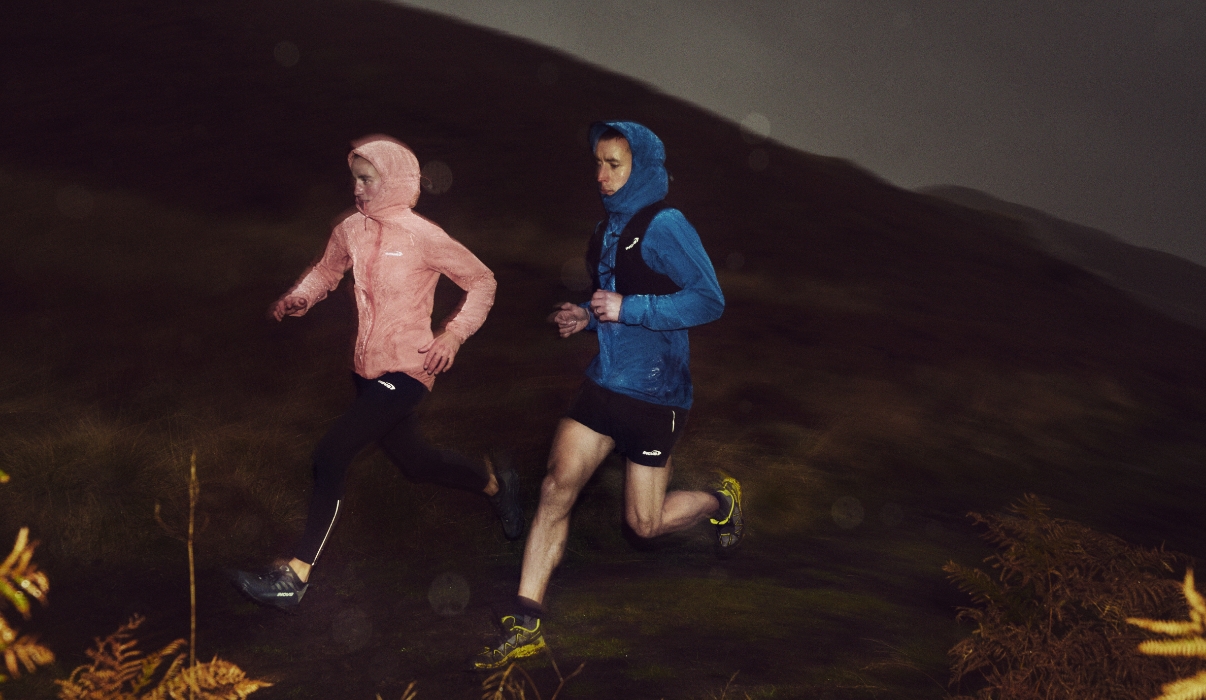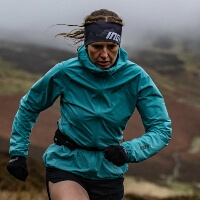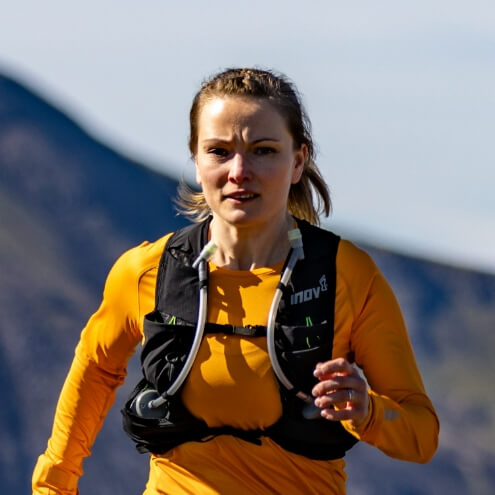
As the weather turns colder, it can be hard to get yourself out of the door on that run. So, we’ve put together some top tips for running in the cold. Covering everything from motivation and planning to gear and training, our athletes share some sage advice for running in wintry conditions.
1. Prepare the night before
When it’s cold outside it can sometimes be a massive battle to get yourself out the door. For one thing, we tend to wear a lot more kit in winter – which takes longer to find and put on. That in turn allows more opportunity for your brain to talk you out of the run you had planned!
So take control. Prepare your gear the night before your run so that it’s as easy as possible when you’re ready to run.


“I run early in the morning, so I set all my clothes out the night before next to my bed. I set my shoes next to my phone, and my gloves and hat next to my keys. Once my alarm goes off, I power myself out of bed, quickly get dressed, make coffee, and get out on my run. This technique keeps me from thinking too much about how tired I feel or how cold it is.”
Cory Keehn
2. You get to do this, you don't have to do this
It’s easy to forget sometimes that running is a choice and a privilege. One day we won’t be able to run, and there are many people who would like to run who can’t. It’s easy on those wintry days to feel the lure of staying in the warm. Flip your thinking from the negative idea that you have to go out, and instead appreciate the fact that you get to!


“If you tell yourself you HAVE to go running it can feel like a massive, wet, windy chore. But if you say to yourself ‘I GET to go running’ it can really change the game and make it feel like a bit more of an exciting adventure.”
Allie Bailey


“Before my run I take 5 mins appreciating that I am able to run, and reminding myself that cold-weather running is magical.”
Ida Mathilde Steensgaard
3. Take a Vitamin D supplement
Vitamin D is a really important vitamin for runners – put simply it keeps our bones and muscles healthy, as well as helping our immune system. While you can get some Vitamin D from food, we tend to get most of it from sunlight. In the winter we don’t get as much sunlight, so it’s worth taking a good quality supplement to top up.


“I take Vitamin D & Calcium tablets in the winter. It helps keep levels topped up for my immune system and bone health. When working night shifts I often don’t see daylight at all so it's really beneficial.”
Nichola Jackson
4. Make the most of the daylight with flexible working
More of us are enjoying flexible working than ever before. Your company may grant a temporary or more formal flexible working request to help you fit your training in around work. It’s obviously at the discretion of your employer, but you may be able to:
- Start and finish later to get a daylight morning run in before work
- Start earlier and/or finish later to get a longer lunch break to train in
- Condense hours into fewer days to give you more time on heavier training days. For example, you might work an extra hour three days of the week to allow you to take a longer break on the other two


“If possible, alter your work schedule. It’s a tactic I’m fortunate to be able to use in winter when I chose to ‘split shift’ so to speak. This enables me to head for the trails and get my daily exercise in during daylight hours instead of the cold, dark evenings.”
James Forrest
5. Warm up before running
When it’s cold, your body reduces blood circulation to your extremities. Spending 10 minutes warming up will get the blood pumping, making it less of a shock when you head outside. In addition, a thorough warm-up routine will reduce your risk of injury.


“Try to warm-up as much as possible while still indoors. It could be anything from a few squats, lunges and dynamic stretching to a full-on dance party to some good tunes. The latter will definitely help to get out in the cold, dark winter!”
Anete Svilpe
6. Pick the right shoes for the job
A great road option is the ROADFLY, which has been built different so that it reconnects runners to the road. Alternatively, the TRAILFLY is the perfect choice for running over hard-packed trails.
If you’re looking for trail running shoes that do it all, the TRAILTALON are designed to handle everything. They’ll give you grip and traction through muddy, boggy ground, but also perform brilliantly on hard surfaces too. And for those slippy, sloppy, muddy runs our MUDTALON shoes will help you get a grip on even the boggiest ground.
7. Have things ready for when you get back
When you get back from your run you’ll likely be wet and cold. Taking some time before your run to set out some warm clothes and a towel means that you’ll be able to get dried off and changed straight away.


“Have something to look forward to post-run. Hot Chocolate is a favourite and helps get the body temperature back up. I love cups of hot chocolates after my runs in the winter!”
Alison Walker
8. Build base fitness and start a strength & conditioning routine
Winter is the perfect time to build up for your spring and summer races. Logging those slower runs to build base fitness and concentrating on strength and conditioning, will pay dividends when the weather gets warmer.


“Spend winter-time building a good foundation of fitness for the race season. Don’t get sucked into doing hard sustained interval sessions too early!”
Kat Townshend
9. Layer clothing to stay warm
The best way to stay warm during those cold winter runs is to use a layering system that allows you to take layers on and off as you get warmer or colder. The classic layering system is:
- Technical base layer – a next to skin layer to wick sweat away from your body
- Mid layer – a warm layer to add on colder days
- Outer waterproof shell – to keep the weather out
You may not need all three layers for your run, but if you’re heading out for a longer run, particularly in the hills, it’s wise to carry layers to add if the weather turns or the temperature drops. Equally as you warm up you may want to remove a jacket for instance – having a waist or hydration pack to stuff it into will be really useful (no one wants to carry a jacket in their hand for several miles!).


“Layers, layers, layers! I like to make sure that I have the ability to add and remove layers to keep the temperature at the right level.”
Andy Berry
10. Enjoy the wintry conditions
Winter is a great time of year to run. It can be beautiful on the trails in particular. As a runner you get to experience it in a way other people don’t. Take some time to appreciate the view – whether that’s stopping to immerse yourself in the silence, or taking a photo to remember the moment.


“Get out, enjoy the silence, the snow, and the beauty of nature.”
Luzia Buehler
11. Always take hat & gloves
Wearing or carrying a hat and gloves is a must when running in cold conditions. If it’s raining you may want to consider waterproof gloves/mitts for longer runs too. Our Thermal Mitt is a great choice here – these versatile gloves offer waterproof protection as well as keeping your hands toasty and warm.
A lot of our athletes favour a wrag or snood to keep their head/neck warm. These flexible pieces can be used as a bandana, hat, neck or face warmer.


“Take a wrag/buff/snood (ace for warming head, hands, neck or face and more importantly wiping your nose).”
Damian Hall


“Museum gloves under running mitts. You can buy them cheap and reuse them - they act like a silk liner but are much cheaper than running gloves!”
Allie Bailey


“Double buffs: one on your head and one around your face.” NOTE: our SNOOD comes in a two pack for this very reason!
Sarah Perry


“Take mitts for when your hands get cold and get a size larger than usual so that you can put your hands in with other fingered gloves on.”
Nicky Spinks
12. Grab a headtorch & run in the dark
One of the best things about the colder months is that you get to run in the dark more. A good headtorch will light your way whether you’re running on roads or trails – it will also make you more visible to road users.


“A run under headtorch on a crisp, clear winter’s evening is almost unbeatable. Just don’t stray off the trail (or in my case the flag stones on Ilkley Moor) and end up chest deep in a bog of eternal stench.”
Tom Roger Adams


“Get a good headtorch (300+ lumens will have you skipping along) and embrace the winter.”
Damian Hall
13. Pack intelligently
Whether you’re wearing a waist pack, hydration vest or running backpack it’s important to know where everything is. You may need to quickly add or remove layers, access food or other items.
Keep anything you’re likely to need stashed where you can easily reach it, preferably without the need for you to remove your pack.


“Anticipate problems and have important kit close to hand for if the weather changes or you face a problem. I always make sure my gloves, over mitts, hat and map are the most easily accessible, preferably in a waist pouch or pocket.”
Jack Scott
14. There no shame in hitting the treadmill
Tip 14 of how to run in the cold is: avoid the cold and run on a treadmill! There is absolutely no shame in using a treadmill for training – particularly for more structured sessions such as hill workouts.
Depending on the conditions outside it might be safer to hit the treadmill too. And if it’s a choice between running on a treadmill and not running at all, we’d pick the treadmill every time!


“So many runners hate the thought of hitting a treadmill for their workout, but I have never fully understood why. In my opinion, every runner could get something out of using a treadmill in their training.
While you can’t compare treadmill running directly to running freely through the mountains or trails, it is a tool that can help prepare your body to go a bit further or a bit faster.” NOTE: Check out record-breaking ultra-runner Andy’s 3 treadmill hill workouts for runners.
Andy Berry
15. Do more social runs
It’s harder to run in the winter. Arranging to run with someone else will make you more likely to put in the miles and could also help boost your mental health. You could run with friends, a local running club or shop, or even make a conscious effort to get to your local Parkrun more.


“Run with your friends in wintertime. Depression is more common in winter, so use the dark to do more social runs.”
Luzia Buehler
